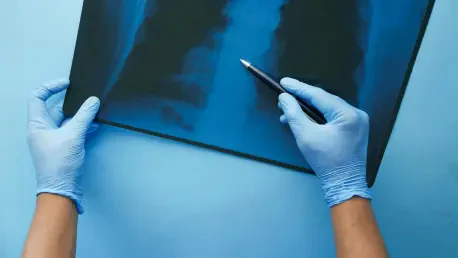Fixed version:
Imagine a bustling emergency room where every second counts, and a single missed detail on an X-ray could mean the difference between a swift recovery and prolonged suffering for a patient with a subtle fracture. St. Luke’s University Health Network is tackling this high-stakes challenge head-on by integrating cutting-edge artificial intelligence into its diagnostic processes. As the first in its region to deploy Gleamer BoneView AI technology across all emergency departments and urgent care centers, St. Luke’s is redefining how bone trauma is detected and treated. This innovative tool assists clinicians in analyzing X-ray images with unprecedented precision, ensuring that injuries like fractures or dislocations are identified quickly and accurately. By embracing such advancements, the health network is not only enhancing patient care but also setting a new standard for emergency diagnostics in the healthcare industry.
Revolutionizing Emergency Diagnostics with AI
Enhancing Accuracy Through Advanced Technology
The introduction of Gleamer BoneView AI at St. Luke’s marks a significant leap forward in medical imaging capabilities. This sophisticated tool, built on deep learning algorithms and trained with a vast database of X-ray images, excels at pinpointing abnormalities that might elude even seasoned professionals. By highlighting areas of concern with visual markers, the system draws attention to subtle issues such as mild buckle fractures or effusions that could otherwise go unnoticed. Clinical research underscores its impact, showing a reduction in missed fractures by as much as 30 percent. Dr. Robert Fournier, Chairman of Radiology at St. Luke’s, has noted that this integration streamlines the diagnostic process, offering speed and consistency that directly translate to better patient outcomes. The ability to catch these critical details early ensures that treatment can begin sooner, minimizing complications in fast-paced emergency settings where every moment is vital.
Supporting Clinicians with a Digital Ally
Beyond improving detection rates, Gleamer BoneView AI serves as a vital partner to clinical staff by acting as an additional layer of scrutiny during image reviews. Emergency departments often operate under intense pressure, with physicians juggling multiple cases simultaneously. In such environments, the AI provides a reliable second perspective, enabling faster initial interpretations before a radiologist’s final assessment. Dr. Rebecca Pequeno, Chair of Emergency Medicine at St. Luke’s, describes this technology as akin to having an extra set of eyes, enhancing confidence in early diagnoses. With the system processing over 1,000 X-ray images daily across the network’s facilities, its capacity to manage high volumes efficiently is evident. This support not only alleviates some of the workload on medical teams but also ensures that patients receive prompt and accurate care, reinforcing trust in the diagnostic process during critical moments.
Broader Implications and Future Horizons of AI in Healthcare
Scaling Innovation Across the Network
The rollout of Gleamer BoneView AI reflects St. Luke’s ambitious vision for technology-driven healthcare, with the system now fully implemented across all hospital emergency rooms, including the Grand View campus in Sellersville. This comprehensive deployment, completed after initial testing at select locations, demonstrates a commitment to ensuring equitable access to advanced diagnostics for all patients, regardless of where they seek care within the network. Handling a substantial daily caseload, the AI tool proves its scalability and reliability in real-world settings. Moreover, St. Luke’s extends its use of AI beyond bone trauma detection, incorporating it into areas like stroke diagnosis and predictive analytics for conditions such as sepsis. With over 100 AI initiatives in progress—roughly a third already embedded in clinical workflows—this health network is positioning itself as a leader in leveraging technology to enhance operational efficiency and patient well-being on a large scale.
Shaping the Next Generation of Medical Professionals
An often-overlooked benefit of adopting AI tools like Gleamer BoneView lies in their potential to enrich medical education. At St. Luke’s, residents and fellows gain invaluable exposure to state-of-the-art imaging technology, preparing them to navigate and innovate within an increasingly digital healthcare landscape. Dr. Fournier has highlighted how this hands-on experience places trainees at the forefront of medical advancements, equipping them with skills that will define future standards of care. This educational aspect underscores a dual purpose: not only does the technology improve immediate patient outcomes, but it also builds a foundation for long-term progress by fostering expertise among emerging clinicians. As these professionals carry forward their knowledge, the ripple effects of such training could influence broader adoption of AI tools across other institutions, amplifying the impact of St. Luke’s pioneering efforts in emergency diagnostics.
Reflecting on a Milestone in Healthcare Innovation
Looking back, St. Luke’s University Health Network achieved a remarkable feat by becoming the first in its region to integrate Gleamer BoneView AI across its emergency and urgent care facilities. This deployment elevated diagnostic precision, accelerated image analysis, and provided crucial support to clinical staff under demanding conditions. It also offered a unique training ground for future physicians, embedding cutting-edge technology into their learning experience. As part of a wider array of over 100 AI projects, this initiative cemented St. Luke’s reputation as a trailblazer in healthcare innovation. Moving forward, the focus should remain on expanding such technologies to address other diagnostic challenges, ensuring continuous improvement in patient care. Collaborating with other health systems to share insights and best practices could further accelerate the adoption of AI, paving the way for a future where technology and human expertise work seamlessly together to save lives.









